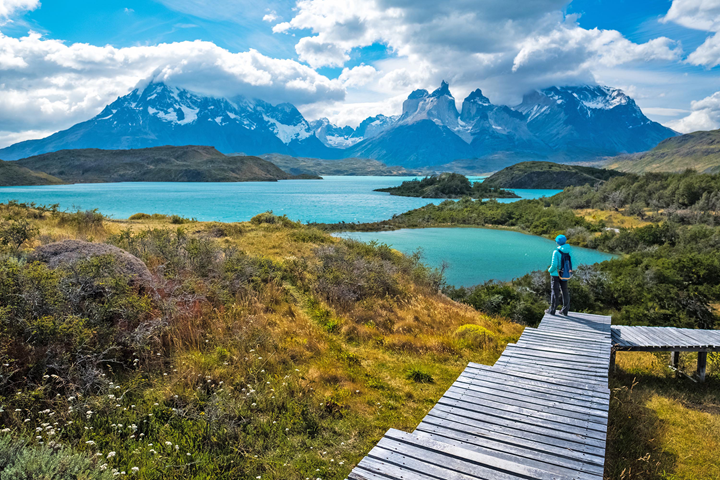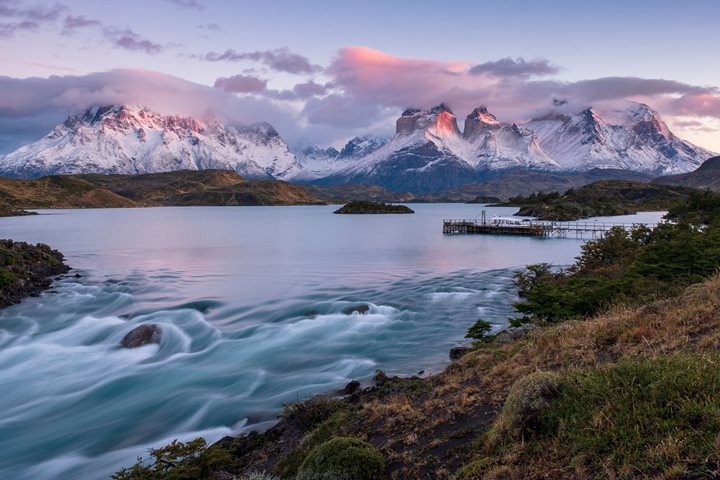I have visited the mountains and fiords of Patagonia dozens of times over the past twenty years, and I can say with complete certainty that there is always something new to discover: meeting residents of the little villages that cling to the granite shores or witnessing the dramatic storms that swirl through the mountains, then suddenly dark clouds break open to reveal the soaring spires of the summits. One experience I never tire of is observing Patagonia’s fascinating and remarkable wildlife, including the "Big Five" species that every visitor will particularly look forward to seeing.
Guanaco
Photo: David Cothran
Although you might not expect to find camels in South America, that is what guanacos are—close relatives of the humped beasts of burden in Africa and Asia that were isolated here when the great supercontinent of Gondwana split apart approximately 100 million years ago. Guanacos live in small herds; females and young animals are guarded by a dominant male who usually keeps a lookout for threats from high ground above the group. Watching these large herbivores move through the rugged, scrub-covered hills of Patagonia is like looking through a window into the wild past of our planet.
Puma
Photo: David Cothran
Torres del Paine National Park is one of the crown jewels of Patagonia, world famous for its incredible mountain scenery. It’s also one of the best places in the world to encounter pumas face to face. Also called mountain lions or cougars, pumas are the largest wild cat in the Americas, powerful and exquisitely graceful predators. Spotting them in the rugged landscape of Patagonia is a huge thrill, whether from a vehicle or, as once happened to me, around a turn in a lonely trail, only about 60 feet away. Pumas in Torres del Paine are very well fed on the large herds of guanacos there, so this big, beautiful cat was totally unconcerned with me as it padded silently down the trail, turned a corner and disappeared.
Watch this remarkable puma encounter in Torres del Paine. >
Andean Condor
There’s more than one way to measure a bird. While the wandering albatross (one of the Big Five of South Georgia) has the longest wingspan of any living bird, combining wingspan with weight makes the Andean condor the largest flying bird in the world. But size really doesn’t matter—statistics are quickly forgotten when you see these magnificent mega-vultures riding the winds around the highest peaks of Patagonia. Andean condors are declining through much of their range, but in Patagonia their population remains strong and it’s still possible to see a dozen or more of these huge birds circling together over a windfall of carrion.
Darwin’s Rhea
Photo: David Cothran
Ostrich, emu or rhea? These birds all look quite similar, but all you need to know to identify them is which continent you are on. Ostriches are found only in Africa, while emus are confined to Australia, and the two species of rhea are residents of South America. We often see Darwin’s rheas walking slowly through the scrub in the Patagonian grasslands, but they can be tough to spot. Their shaggy grey and brown plumage blends perfectly with the low vegetation, particularly since they look exactly like a small bush when their heads are down for feeding. They are strange and wonderful birds; a good look through binoculars makes it perfectly clear that they are dinosaurs that survived to the present day!
Magellanic Penguin
Photo: David Cothran
It may seem a little surprising to find penguins in Patagonia—a thousand miles north of Antarctica—but Magellanic penguins are right at home here. In fact, there are over a million of them in South America and they are sometimes found as far north as Brazil, well into the tropics! These dapper little birds belong to the group called banded penguins, which are very well turned out in the classic penguin tuxedo, complete with a bow-tie band. Unlike their Antarctic cousins, they nest in burrows dug into grassy banks and when visiting their large colonies, we usually see them standing guard outside the entrances to their tunnels—great for photo ops.





